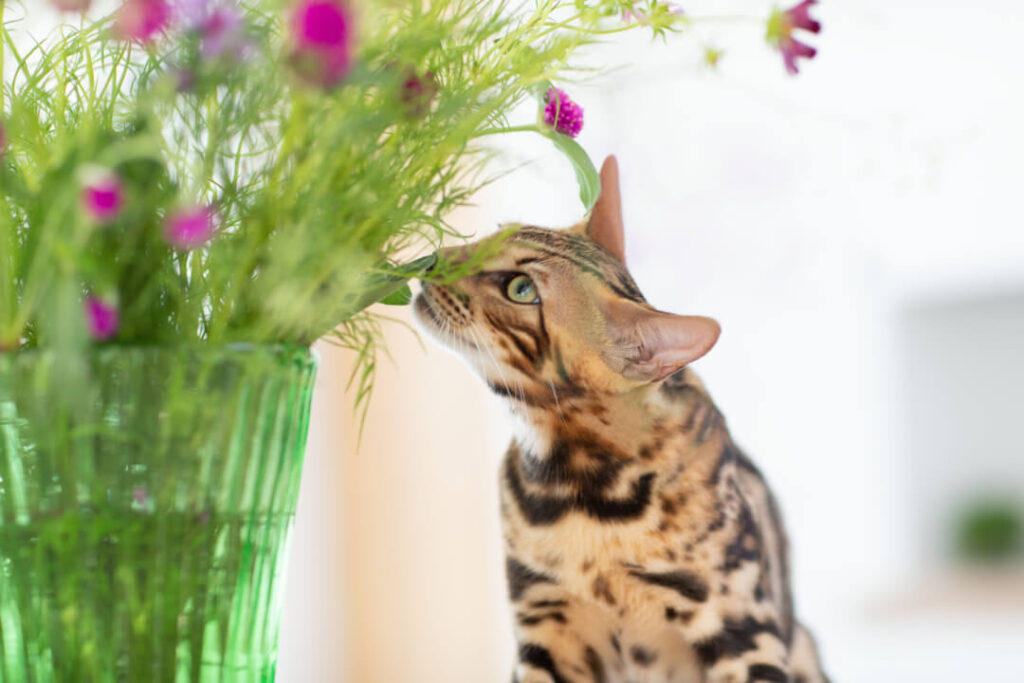Do you want to train your cat to use the litter box – but are not sure how?
– Here are some tips and tricks for you!
German songwriter and comedian Helge Schneider wrote a satirical song about litter box happiness (“Katzeklo”): The cat toilet belongs to the cat household’s basics and is essential when it comes to cleanliness within the four walls.
This also applies if your cat is an outdoor animal, spending most of its time outside the flat, including “doing its business”. Outdoor cats also like to have the option of their own loo once they come back in. Do not be surprise if you find droppings on the carpet, bed or elsewhere, if no litter box is supplied.
Basic rules for the minimum number of cat toilets available.
Number of cat toilets = number of cats + 1
Why is my cat unclean?
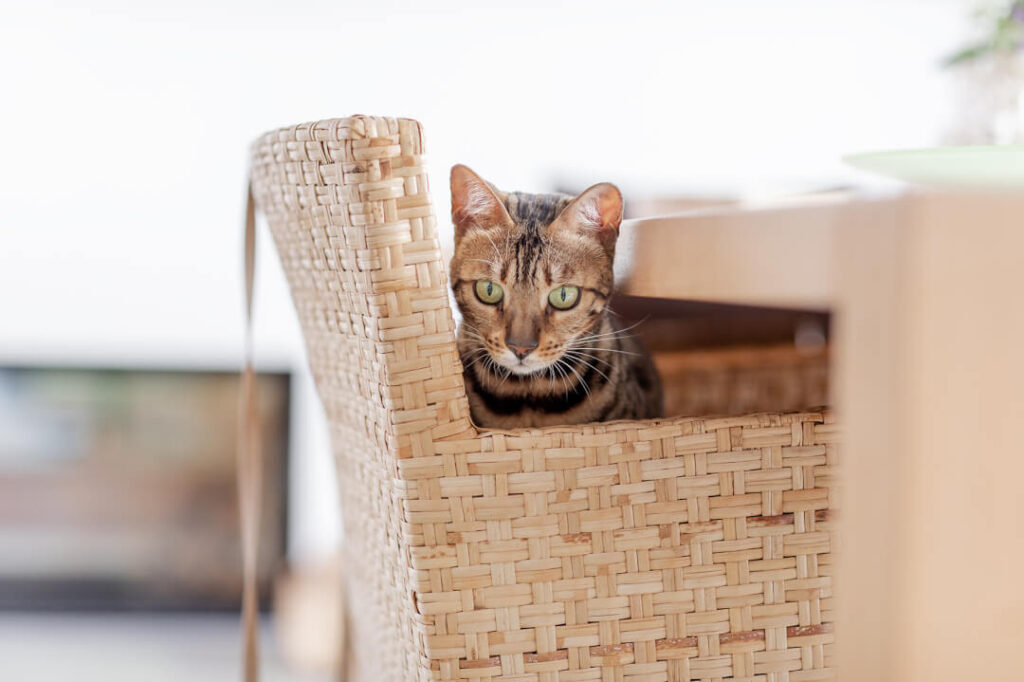
Once the expensive Persian rug or the new designer sofa is wet, even the most serene cat lovers will get irritated and worried.
Why has my feline friend suddenly become “unclean”?
Until it seemed to be fine with using the toilet!
Nothing irks a cat owner more than the fact that the animal has become unclean. First of all, try to stay calm! Drastic measures such as yelling at the cat, following it with a water pistol or pressing its nose in the dirt are not only cruel and unproductive but can also lead to ultimate loss of trust. The result may be the exact opposite behaviour than the one you want to achieve
– therefore never do such things!
NEVER!
If your cat changes its behaviour, there certainly is a cause behind it! Try to find its source and you will be able to avoid any repetitions of “mishaps” in the future.
Immediate action required
If your cat has chosen a new spot outside the litter box, this calls for immediate action:
You immediately need to make the place as unattractive as possible – either by keeping the door to the room closed at all times or by moving the furniture.
You can also move the feeding spot right there – cats never soil the spot where their food is.
You can also cover it temporarily with a plastic or aluminium foil to make it uninteresting for the cat.
You also need to set up a litter box near the “no-go” spot – which then needs to be moved closer to it bit by bit, every day.
If even the most thorough cleaning has no effect, the respective blanket or carpet need to be completely removed, because the spot is likely to be used again in the case of any remaining odours.
Thorough cleaning
If something got spilled…
- use hot water and a neutral cleaner first.
- then use a cloth wetted with 40% rubbing alcohol from the pharmacy – rub in thoroughly.
- conclude with a special enzyme cleaner (available in the pet shop).
It will dissolve both the fat and the urine crystals – meaning that the odour will vanish completely, even to a sensitive cat nose!
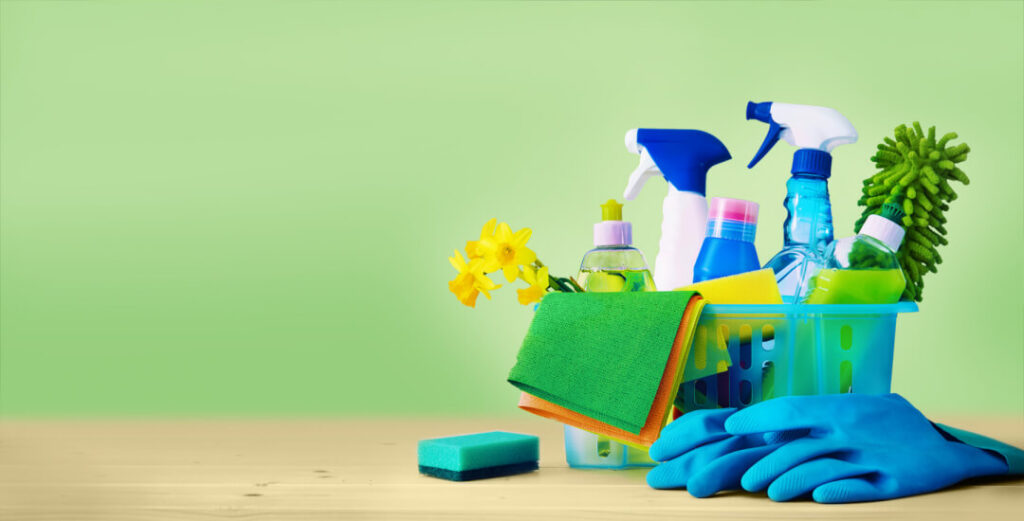
Possible reasons
Uncleanliness and marking can have many reasons:
Did you move the litter box, is the litter too rough and hurts the velvet paws? Or maybe the box is too small, badly positioned or not clean enough? Does the animal have health problems or is it stressed out by a recently changed situation?
– There is a whole range of possibilities which need to be checked! More often than not, changes in the immediate environment are the reason for unwanted behaviour.
Or does the cat avoid the litter box and its content because it is not filled properly or even unclean? Soiled litter puts cats off, which comes to no surprise as they have highly sensitive noses and react to the stinging smell of urine even more strongly than humans do.
Psychological stress
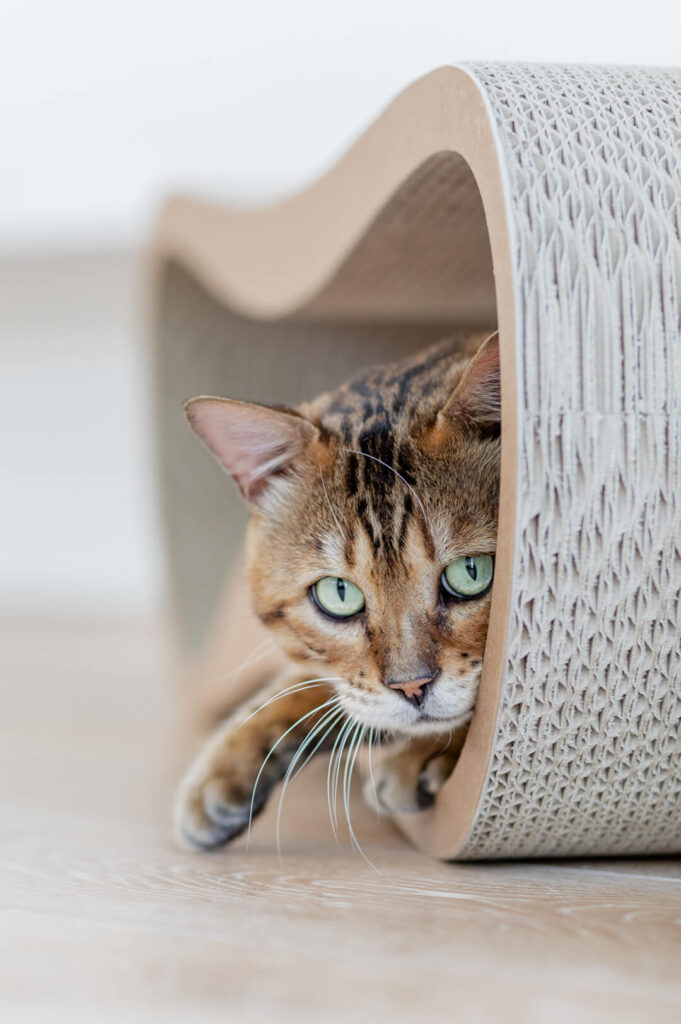
Is your cat stressed out by a changed living situation due to relocation, competition or new furniture, family growth, grief, divorce, changing presence times, etc.?
Or is it maybe processing traumatic experiences (e.g. aggressive dogs, New Year’s Eve?) Maybe intruders have used the cat flap to enter your cat’s territory? Does your cat need more affection?
Health problems
Does the animal have any health problems (e.g. bladder infection, diarrhoea)? Is it old and/or incontinent?
You know your cat best and will find out the reason on closer inspection. If your cat looks or acts differently – you will know immediately that something is up! If you are unsure and suspect an organic problem to be the reason for your cat’s neglect of the litter box, make an appointment with a vet who can check its state of health thoroughly and in detail.
Marking behaviour
A sexually mature, non-castrated cat is prone to marking behaviour. The urine of a grown tomcat has a strong, stinging smell as it contains hormonal odours signalling its current state. Male cats also use it to mark their territory.
Even daily cleaning of the litter box only helps to a point and there is no need to try and cover the odour with a different smell – it will always come through! Only efficient litter and castration will fight the strong odour in the end.
Untrained cats
Kittens usually learn how to use the cat toilet from their mum and siblings. They simply observe and copy what they see.
If a kitten is separated from its family too early, it may have missed out on the lesson. In that case, you have to take over and show your feline friend what the box and its content is meant for. During play time, in the heat of the moment so to speak, it may happen that the little ones forget to use the litter box – not much of a difference there to small humans!
House-training your cat
If a kitten learns how to behave e.g. through enthusiastic praising and cuddle rewards from an early age, the co-living will be much more harmonious from the beginning. However, it is very hard to train adult cats, especially when it comes to changing behavioural patterns. Cats love routine and can be quite obstinate.
They may not understand the reason behind your wishes – and how should they, if things were always fine the way they were? It did not seem a problem until now, did it?
Here are some valuable tips for making the co-living with your kitten work out smoothly from the very beginning:
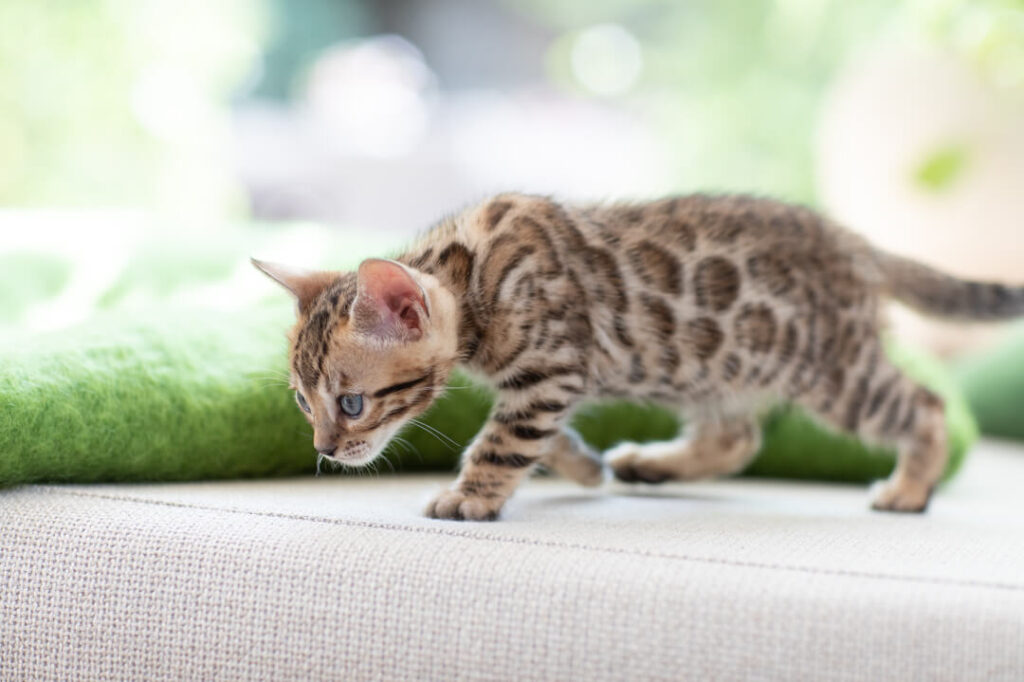
Kittens and the cat toilet
At the age of three to six weeks, kittens are old enough to be trained to use the cat toilet.
To this end, special plastic bowls are available at the pet shop which feature a low cut-out of the rim as well as a rippled entry help, making it easier for the little ones to access and leave.
As soon as the kittens start to eat substantial food, the cat mother stops cleaning them. Now, you should have the litter box at the ready, placing it in close vicinity to the nesting box. It is essential to keep the kitten-loo extremely well cleaned, otherwise alternatives may be sought-for in unwanted places throughout the apartment.
Praise and cuddles will help to connect the litter box use with positive feelings!
Use the breeder’s litter
The big day has come: Your cat is moving in! The new inhabitant will need a toilet with species-appropriate litter that guarantees perfect hygiene and safety.
To make sure that the kittens recognise it, you may want to use the same litter as the breeder for your own cat toilet. – Thus, they will feel more at home immediately!
Do not use clumping litter for kittens
Young cats are naturally curious and will inspect the litter box on their own accord. To avoid unwanted effects from accidental swallowing of pellets, a plant-based, non-clumping litter is the best choice for kittens.
Cat’s Best Comfort is made of pure plant fibres and can be digested without any problems. After a short while, the cat – smart as it is – will have realised that the litter is not meant to be eaten anyway.
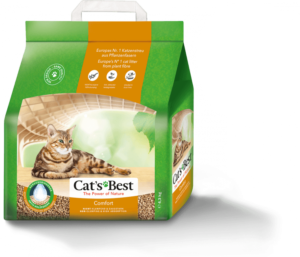
Start with the training at once
Just after opening their eyes for the first time, kittens will start observing their mother’s behaviour. What on earth is she doing in that box? Once they are mobile, they will go and copy her actions.
Place the litter box in close vicinity to the nesting box or sleeping spot so that the kittens can watch the proceedings. Once they need to do their business for the first time, they may already have understood its purpose.
Activate your kitten’s digestion
Usually, the cat mum activates her kittens’ digestion. From a certain age onward, this should not be necessary any more.
However, you can use this behavioural pattern for litter box training once the kittens are in your own home. Simply imitate the mother’s licking by gently massaging their belly after the meal – and put them in the litter box right afterwards. Things will function a little easier that way and after a few times, the little ones will know that this is the place to “do their business”.
Mind the size of the litter box
While choosing a cat toilet for the offspring, make sure not to buy a “mini toilet”. It may serve the purpose just fine for a little while – however, after only a few weeks it will have become much too small already. Obviously, the market offers a variety of “cute” variations!
However, even if you are tempted to go through with the purchase, mind that you cannot expect too much! Because this is about your cat and its comfort. Form, colour and design may appeal to you but in the end it is your cat – who uses the toilet. Therefore, lids and flaps are to be avoided – they may only present hindrances for your cat.
Put the kitten in the box after feeding
Shortly after feeding, place the kitten in the litter box: The possibility of immediate relief after a meal is very high.
Also, behaviour like withdrawal to a quiet space, or repeated turning and scraping of the floor means you should put your cat in the toilet. However, don’t overdo it! Jumping up and putting your cat immediately in the box after each small treat may turn the toilet theme into a trauma at some point.
Carefully dispose of the droppings
Kittens are as odour-sensitive as their grown relatives – bad smells are disturbing to them and they will always steer clear of anything smelly. Therefore, you should try and keep the toilet spotless! To make sure that the kitten feels comfortable, you should get rid of the droppings several times a day: Faeces and soiled spots should be removed and the box refilled with fresh litter. That way, the litter box will stay a place of well-being which the kitten will be glad to use.
Do not clean too often in the beginning
Has the kitten done its business in the litter box for the first time? Great! – pet and praise it excessively – thus, the result will be marked as positive. If the excretions have not been covered completely, you can do the rest: Simply cover them with litter to show the kitten how this is done.
However, do not clean the box immediately afterwards and leave everything as it is for a while. Even the weekly complete change can sometimes be skipped in the beginning. Odour and process will thus be connected to a unit in your kitten’s brain. They learn quickly and after a few repetitions, they will soon have understood the purpose of the litter box.
Vinegar against uncleanliness?
Once a mishap has happened – how do we get rid of odour and urine spots the best way?
Take a kitchen roll or an old towel at first to mop up the moisture; then proceed to clean the spot with a neutral soap or ammoniac-free cleaner – otherwise the smell will make the cat use the spot even more! Then, you may try and tackle the odour with a vinegar solution – however, this may backfire, as cats abhor the smell of vinegar and in some cases might try to “erase” it by using the spot even more excessively.
Ultimately, an enzyme-based cleaner is always the best choice, as it will not only clean the spot but also eliminates the odour.
Training older cats to use the toilet
With a bit of patience and empathy, also grown cats can be trained to use the litter box.
Before a cat moves in with you, make sure that you are acquainted with its former living situation and preferences:
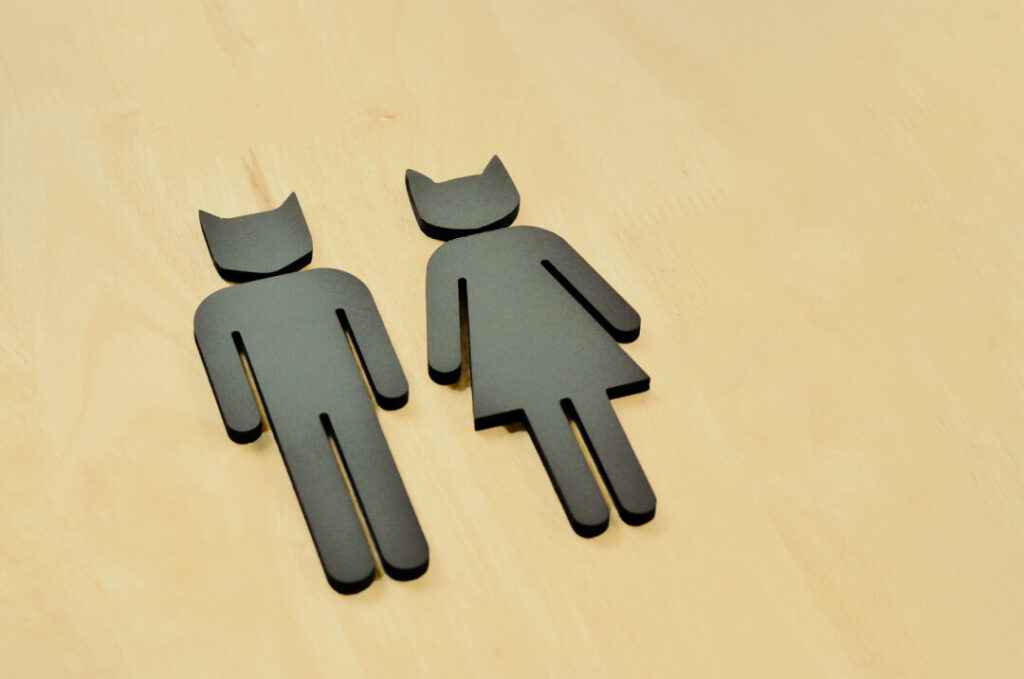
Is the cat used to a litter box already or is it an outdoors roamer who has never seen one in its entire life?
Are there specific cat toilets the shape and design of which are known to your cat from before?
Are there familiar smelling cleaners – or any that the cat hates?
Some cats only accept a toilet cleaned with familiar products – or they need it to be cleaned immediately after doing their business
– otherwise it is a no-go!
What litter does the cat prefer? Maybe there is a favourite brand?
The more information you can gather upfront the easier the change will be – for the both of you!
Use the same litter as the pre-owner!
The content is as important as the litter box itself. On adopting a cat you should ask the pre-owner what brand they use. If you use the same litter in the beginning, your new cat will feel right at home.
In case you don’t like the brand and decide for a change, try the “salami technique”: To introduce a new type of litter, simply start by adding a little of the new to the old, increasing the amount step by step. That way, the cat will hardly realise the change and will be able to accept the new brand without a problem.
Use earth and sand as cat litter
Out in nature, cats do their business by digging a hole in the ground and covering it afterwards.
The most comfortable way is using a spot with loose, dry sand. Thus, the favourite spots are – to no surprise – sand pits and flower beds. Here, loose sand and earth are already at hand! No excess energy is needed to provide easy, comfortable relief.
If your cat stems from a household where no litter box was available and the cat was forced to use the bushes – you can imitate the familiar conditions by filling the litter box with earth and sand in the beginning. That way, the cat feels more comfortable as it is familiar with the content and knows what to do with it!
Provide several litter boxes
As a rule of thumb, you should always set up more boxes than there are cats present in the household. One cat should always have a choice of at least two boxes, two should have three, and so on. Several boxes are the right choice also for cats that like to urinate in a different place than the one used for their droppings. This separation is only achieved by using several sanitary facilities.
If your house or apartment has more than one level, it also makes sense to install at least one box per floor.
Put the droppings in the litter box
A cat that has never used a litter box before may sometimes not know what to do with it. You can help by showing it the purpose:
If the cat has no outside access and, not knowing where to go, has done its business indoors; simply pick up the droppings and put them in the litter box.
Stay calm and gentle and keep a certain distance to the faeces. This is not a punishment, it is meant to be a nice way of introducing your cat to the box and its purpose!
And as such it should also be perceived by your cat. They are sensitive beings and will learn quickly – however, be patient and allow a few days to pass until the cat has learnt to use the litter box on its own accord.
Scrape the litter with your hands
A cat who has never experienced the use of litter will not instantly know what to do with it. Use your hands to scrape around in it a little – and make sure that the cat is nearby to observe the action. The scraping will remind it of the familiar task of scraping the ground before and after doing its business in the wild. It is used to digging a hole and covering its faeces afterwards.
On entering the new territory, your cat should be made familiar with the litter box and get a chance to scrape around in it. Using it playfully will make it easier to acknowledge its real purpose.
The perfect litter box
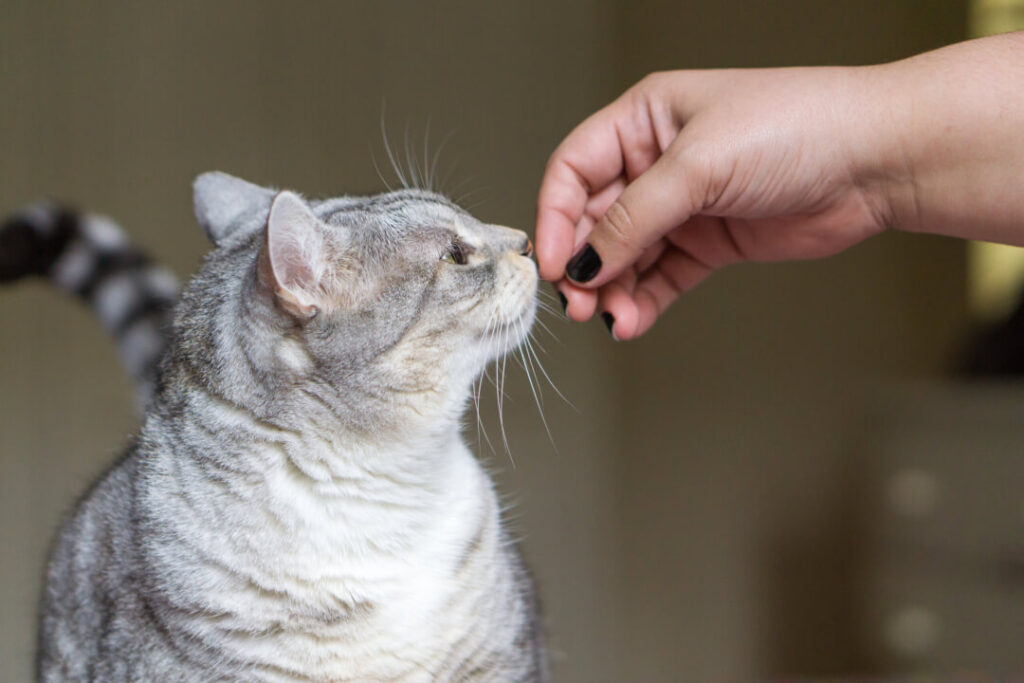
What makes the cat toilet a perfect retreat? Basically, the litter box is perfect once the cat has accepted it as comfortable. If it doesn’t like the box there is no way of making it use it.
Cats, just like humans, like their facilities to be clean as well as spacious. The cat needs enough room to turn inside the box. Some animals like their remnants not only to be covered but thoroughly buried – in that case, make sure that the box is robust and sustainable enough to endure excessive scraping.
Urine and faeces are often left in separate spots and corners; the box should therefore provide enough room. What else should a species-appropriate living environment provide?
Choosing the right litter box
Cat toilets are available in various formats and designs. It is not that easy to choose the right one. Think about what your cat really needs. Don’t be tempted to purchase a litter box for its fancy style – here, function definitely forms the design and the “taste” of your cat is a lot more important than your own!
The type of breed makes no difference. However, bigger cats obviously need more space to move around freely without hurting their tail on the walls. The entry height also is a factor to consider: Very young as well as old cats may have problems with entering a high-sided box.
Some cats do not appreciate a lidded box or one with a flap – in case you want to make sure, it is better to skip those extra features. Dark hues may be considered stylish and hip, however your cat may have different ideas. A dark cave would never be chosen by smart cats in nature as it may hide dangerous enemies! Better choose friendly, light colours for the cat toilet.
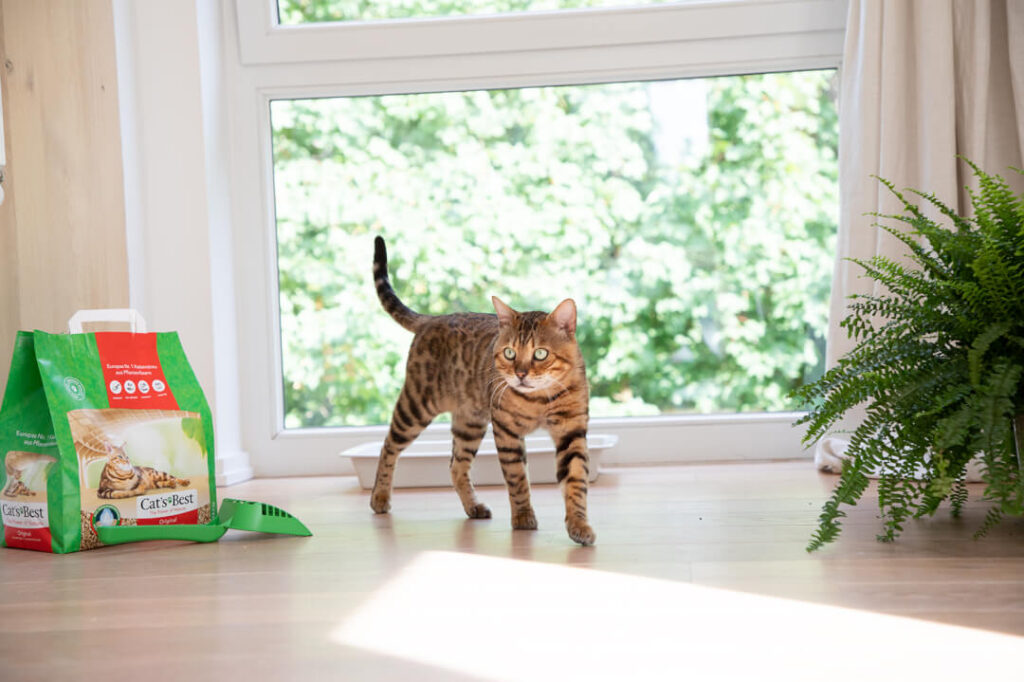
Litter box types
Open or closed?
Many cats don’t like the hooded variation – in nature, they would also make sure not to use a cave for their business. Other cats may not mind a roof over their heads.
However, all of them will appreciate easy access. Ideally, an open litter box should have a rim which is curving inwards: That way, most of the litter will stay inside. For spilled pellets, a special mat can be put in front of the cat toilet. Also, keeping a small, battery-operated vacuum cleaner nearby is always a good idea.
Bowl shaped toilet
Enclosed toilet
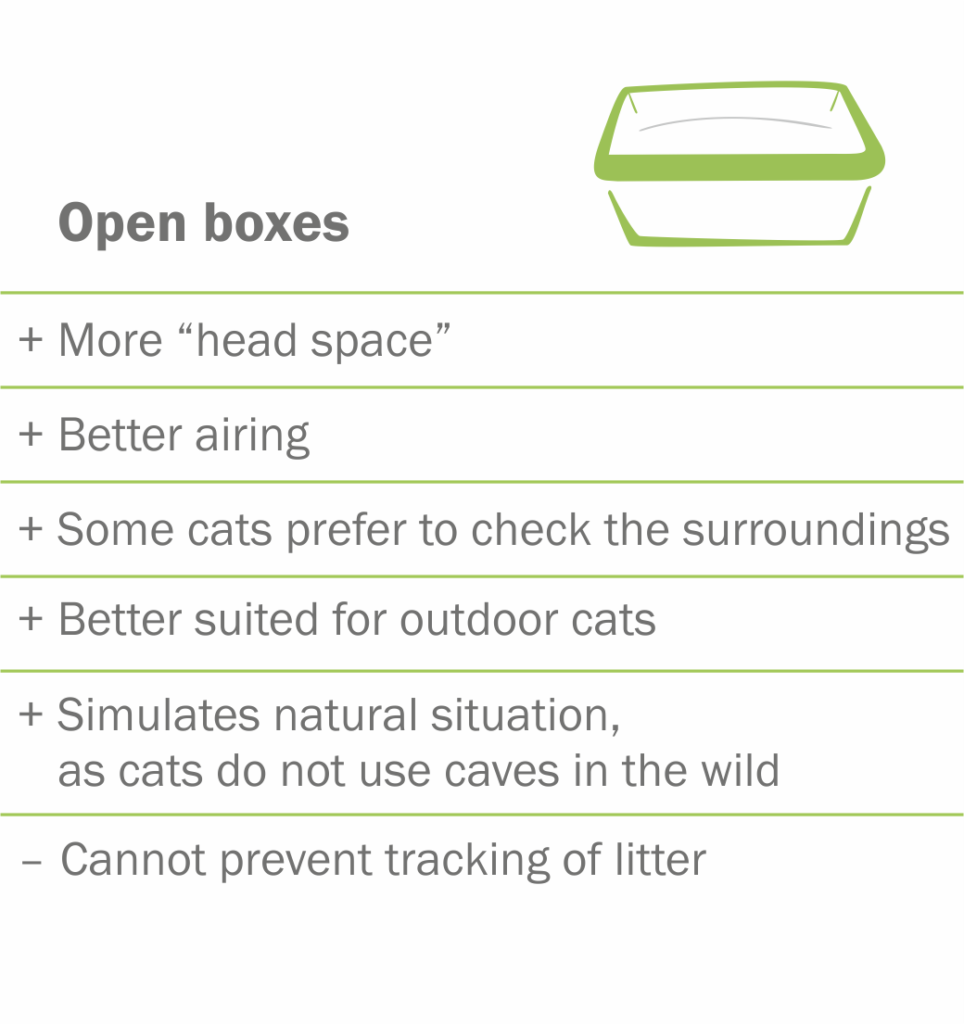
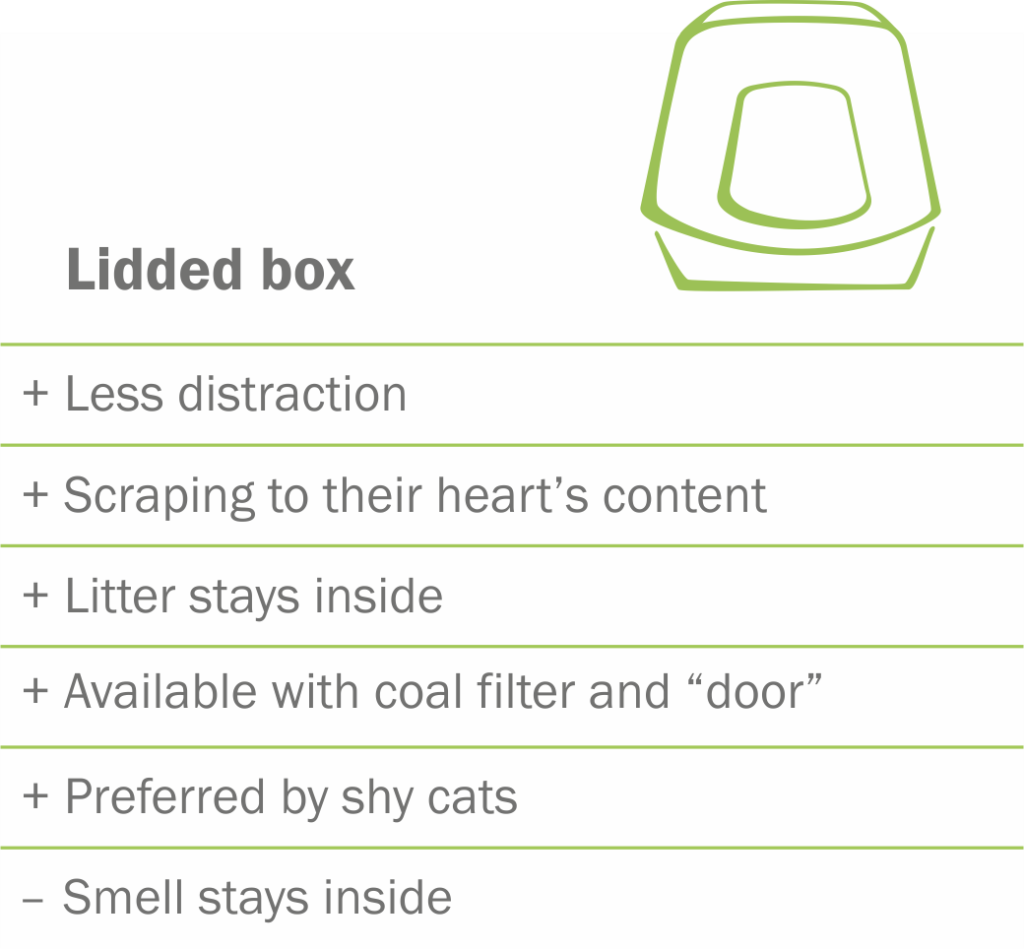
Best spot for the litter box
Humans spend much thought about placing the WC in the right spot inside of the house. This should also be the case with a cat toilet.
Choose a quiet spot where your feline friend will not be disturbed – never set it up right in the middle of the corridor!
Imagine having to use a toilet at a busy traffic junction – what would that feel like? Exactly the same goes for your cat! It will appreciate a discrete refuge to do its business as much as any human.
Separate from sleeping and feeding
Would you eat a snack on the toilet? No? – Why not? OK – there may be certain exceptions but there are none for your cat:
Cats will never eat at the same spot where they relieve themselves – which also goes for the sleeping area. It is therefore never a good idea to set up the litter box in close vicinity to either the feeding or the resting areas.
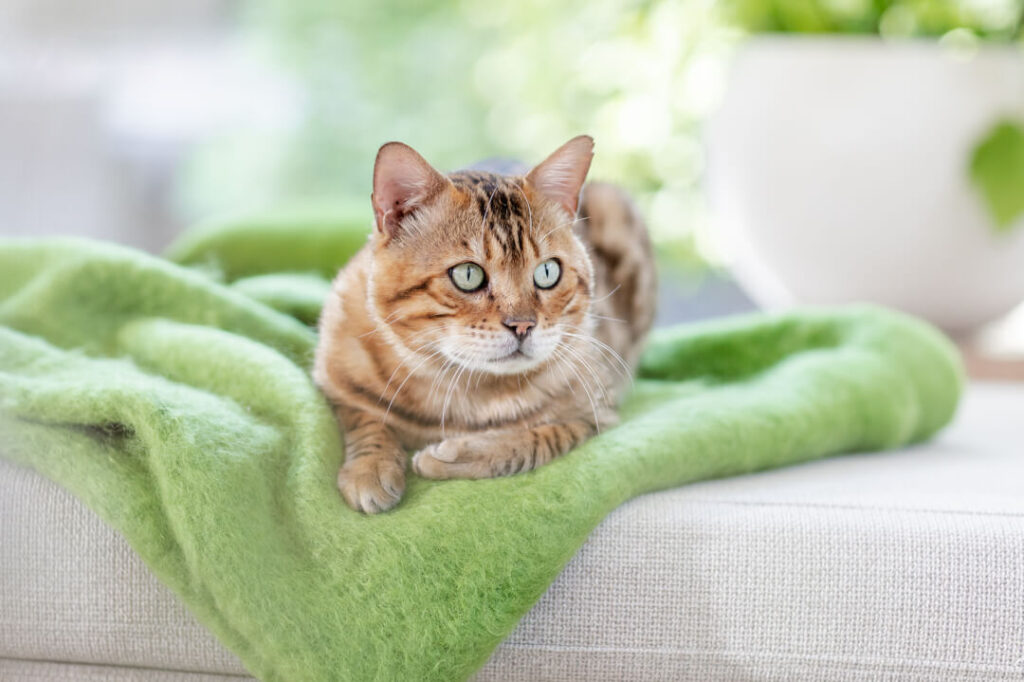
Draught-free area
Make sure that your feline friend finds a separate space for its toilet – far away from the bustle, protected from both noise and draught. On the balcony or right below a window for example never are good spots for the litter box. Imagine having to go outside to do your business – that would not be appealing to you either. That kind of chilly outdoor experience should be left to the die-hard fellows – and even those would always choose a milder climate.
Quiet place
The right spot should meet the cat’s need for discretion and peace. An environment prone to sudden disturbance or noise – e.g. behind doors or next to the washing machine or dryer – should be avoided completely. Otherwise it might happen that the cat will leave the toilet in complete shock or panic and never use it again on future occasions.
Free access
The cat toilet should always be easy to find. No gauntlet through the whole house should ever be necessary – as this will quickly lead to accidents on the carpet.
Cats usually never wear – well, anything – so…Especially kittens, who are not used to the litter box yet, may not reach it in time: In that case, a leaking incident may occur. For the same reason, both kittens and older cats should not have to climb stairs to find the toilet.
Keep the litter box in the same place
“Never change a winning team”! Cats like routine. They will always stick to well functioning processes and love their rituals. Likewise, they hate any unexpected incidences and change is never a good thing if it concerns their immediate environment.
Once the litter box and its space has been accepted, don’t change it. Leave everything as it is and you will be rewarded by a thoroughly relaxed companion whenever it comes to household hygiene.
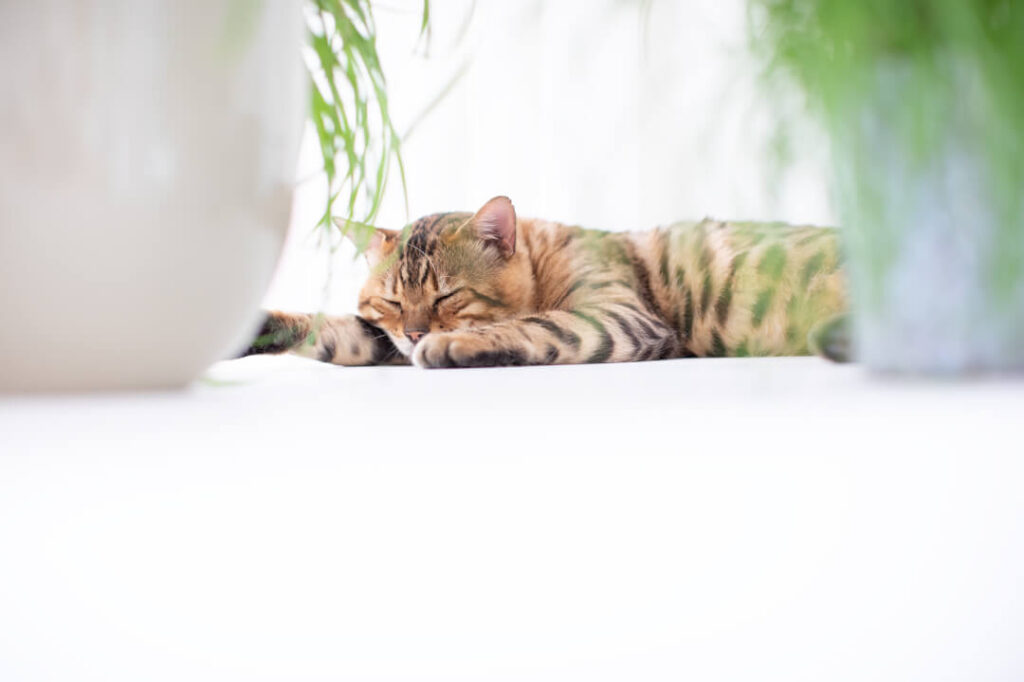
Cleaning the litter box
Smells decide on both the social and territorial behaviour of our feline friends.
If a cat doesn’t like the scent of the litter it might ignore the cat toilet altogether. Too little or soiled litter may put the animals off as well – especially since their noses are very sensitive and they react to the stinging smell of urine accordingly.
Always make sure that the cat toilet is clean and welcoming. Before each complete litter change, you should clean the box thoroughly:
Cat toilet – standard cleaning
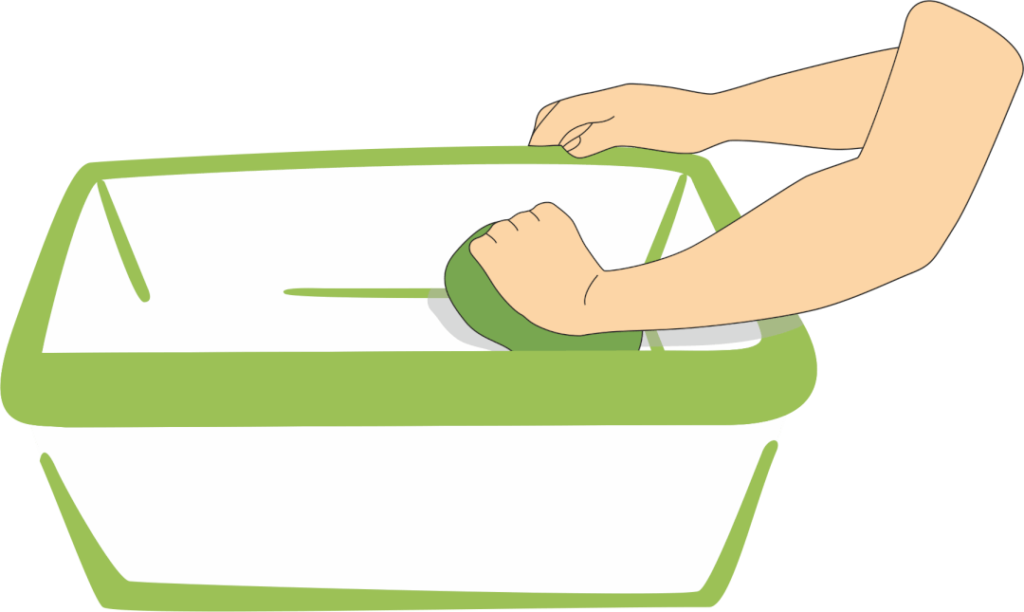
- Empty the tray and dispose of the content
- Put the empty plastic box in the tub or shower and fill it with hot water and a neutral cleaner.
- Leave everything to soak for 10-20 mins
- Empty the box and scrub remnants with a brush or sponge
- Reibe die Schale anschließend mit Handtuch oder Küchenrolle schön trocken
- Put the box in its usual spot and refill it with fresh litter
If hood or lid are part of the cat toilet, these should also be cleaned!
Is human offspring expected? In that case, make sure to always use gloves when cleaning the cat toilet. If you are pregnant, there is a risk of toxoplasmosis infection which is transferred via cat faeces. This means that the cat toilet should be cleaned thoroughly on a daily basis to avoid contact with infectious material. Dispose of used litter and remnants in sealed plastic bags via the household waste.
Cleaning rhythm for cat toilets
The litter box should be cleaned and refilled with fresh litter on a regular basis. It depends on the type of litter how often this should be done. There are vast differences which obviously have an effect on both intervals and economy.
Functionality also plays a role: If you are using non-clumping litter, you will not escape a weekly complete change. Clumping litter however makes things a lot easier: You only need to exchange the entire content every 4-6 weeks and – depending on the brand – will save a lot of money.
High summer temperatures will worsen the smell; here you can learn how to fight it: High summer temperatures will worsen the smell.
Daily cleaning
Soiled clumps, faeces and excretions should be disposed of on a daily basis.
Refill the respective spot with fresh litter. If you don’t get rid of the excretions, your cat might ignore the litter box altogether, even if a complete change has been done only recently. Therefore, it is always better to frequently check for any clumps and to dispose of them immediately.
But don’t worry! – There is no need to get your hands dirty. The best way is to use a special scoop.
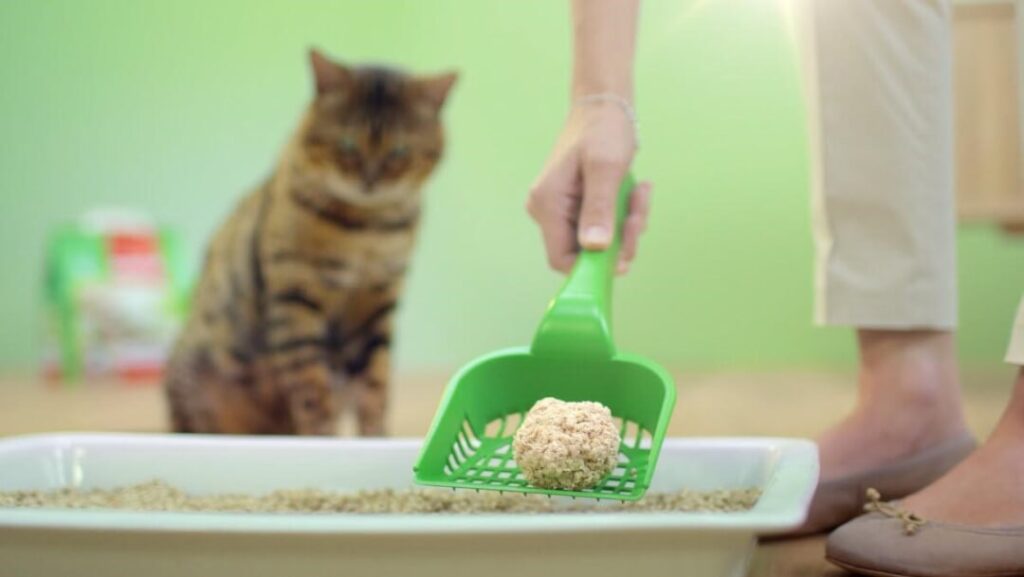
Weekly cleaning
If you are using traditional, mineral cat litter based on bentonite, lime quartz sand or silicate, a weekly standard cleaning of the cat toilet will be inevitable. Completely empty the tray, dispose of the entire content and refill it with fresh litter.
You can also use a neutral, non-perfumed cleaner. However, never use chemicals or strongly scented products! Otherwise the plastic surface of the shell may start corroding – or the cat may refuse to enter the toilet altogether.

Do you love a fresh scent after cleaning?
Here are a few scents your cat will not accept: Ammonia, onion, vinegar – as well as geranium, spur flower or Hildegard-von-Bingen herbs. On using those scents, your cat may simply “evaporate”!
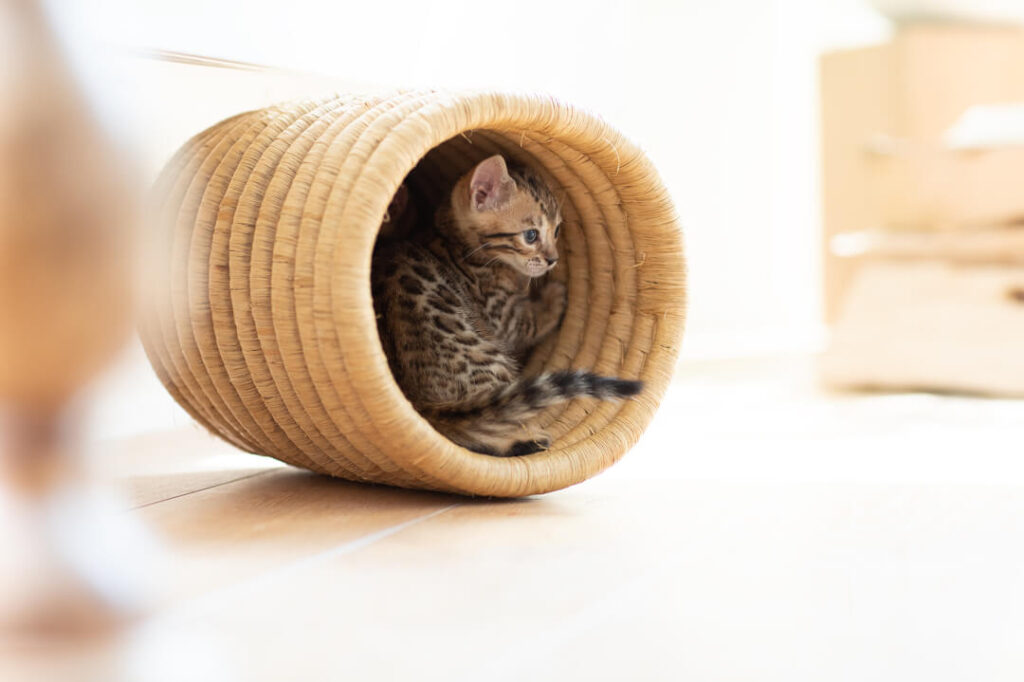
Replace the toilet once a year
Every litter box should be replaced annually or – at the very least – every other year.The scraping and scratching causes little cracks in the plastic surface, resulting in the build-up of residue over time. Plastic foil inlays are not advisable – the claws get caught in them, and through the resulting holes and slits, urine can easily collect underneath.
What cleaner do I use for the cat toilet?
Cats are highly sensitive animals by nature. Their sense of smell is strong and they perceive their environment even through their paws. Rough surfaces, sharp edges, a slippery substance or an artificial smell will all be regarded as disturbing. For cleaning the cat toilet, hot water and a neutral cleaner are the best choice.
Use a litter scoop
The best way to dispose of litter clumps is using a special litter scoop with a lattice spacing of 7 to 9 mm: Thus, only the soiled bits will stick –
the clean litter simply drops back into the box.
Use warm water
Use warm water for cleaning the litter box. The higher the temperature, the more efficient the cleaning process. Grease and grime will simply dissolve more easily.
Use a mild cleaner
Chemical smells will put cats off the idea of using the cat toilet.
Skip on pine-scented or acid-based cleaners, disinfectants or any products containing ammonia. The cleaned cat toilet should then be refilled with 5-7 cm of fresh litter.
What type of cat litter should I use?
In the wild, cats would do their “business” in soft, loose soil.
A hollow will be dug in the ground and the excrements will be thoroughly covered after “going to the toilet” in nature. House cats will try and copy this behaviour by instinct indoors as well; eager scratching and digging will send the litter sailing out the box at times – or it may stick to hair and paws.
How can we create a natural environment at home so that the cat’s instincts will be met as much as possible? Is there such a thing as a “natural” cat toilet for the human living environment? Many cat lovers spend a long time searching and trying out different brands of litter on the search for the perfect natural litter, which also provides an optimum in hygienic levels: The range of products is as diverse as the cats’ and cat owners’ preferences.
Choosing the right litter
The cat litter market can be divided by using several criteria: The used raw materials, e.g. minerals as opposed to plant fibres – or functional factors, e.g. clumping or non-clumping. Further criteria are the consistency, e.g. coarse, fine-grained or pelleted – or the use of supplements (scent, colour or chemicals added to boost the performance).
Mineral-based litter
The raw materials used for mineral-based litter – bentonite, lime quartz sand or silicate – are mined in open pits. In the areas with exhausted bentonite resources, gigantic pits are being left behind and the massive destruction of the environment takes years to heal. Mineral litter has a high net weight, high dust levels and is not compostable. This litter has to be disposed via the household waste – a major strain on landfills.
Mineral clumping litter
Mineral litter is available in both clumping and non-clumping quality.
If you are using non-clumping mineral litter, a complete change is frequently needed; it is thus a lot less economic than other types. In addition to the high consumption levels this litter is also less efficient regarding its odour-absorbing performance.
However, clumping and clumping are not the same! There are extreme differences in consistency, clump isolation, moisture and odour-absorbing performance as well as efficiency.
Silicate litter
Granulated or pelleted silicate litter consists of silica gel. You may know this material from the small silica packs used to ensure dry environments. Litter based on silica gel binds odours relatively well and has low dust levels. It also weighs less compared to bentonite based litters. It is a hard material which makes a loud rustling noise due to its consistency, which may have a disturbing effect on some cats. This litter is never available in a clumping quality. It therefore needs to be changed frequently (short intervals) and disposed of via the household waste.
Organic litter made of plant fibres
Plant-based litter – such as e.g. Cat’s Best – uses the special capillary effect of plant fibres. Moisture and unwanted odours are absorbed and encapsulated deep inside of the fibre. Plant-based litter is especially light in weight and very efficient. It is available in both clumping and non-clumping quality. Plant-based litter decomposes naturally and is therefore completely compostable.
How often do I have to change the litter?
The normal cat diet consists of a lot of meat so that a high amount of ammonia and hydrogen sulphide is being released: the main reason behind the strong smell of cat urine. A high quality litter such as Cat’s Best will tackle bad odours actively on a natural basis:
Moisture is immediately absorbed by the microscopically fine capillaries and encapsulated deep inside. If you are using one of the clumping Cat’s Best litters – e.g. Cat’s Best Original, Cat’s Best Smart Pellets or Cat’s Best Sensitive – you simply have to take out the soiled clumps only (best by using the Cat’s Best litter scoop) and discard it via the house toilet* or the compost.
*please observe local disposal laws
How and where do I dispose of cat litter?
Every type of cat litter can be disposed of via the household waste. Those who prefer comfortable handling in combination with protecting the environment as well as saving money in the long run will not decide for mineral litter and rather choose plant-based brands.
A purely plant-based product such as Cat’s Best is made of raw materials from secondary wood sources: No tree plantations but rather naturally grown trees from sustainable, regional forestry.
The raw materials travel only short distances. The disposal therefore is sustainable in itself – the material is biodegradable and completely compostable. To any gardener’s delight, the plant-based cat litter thus turns into a valuable fertiliser, boosting the garden’s soil life and fresh, green splendour.
